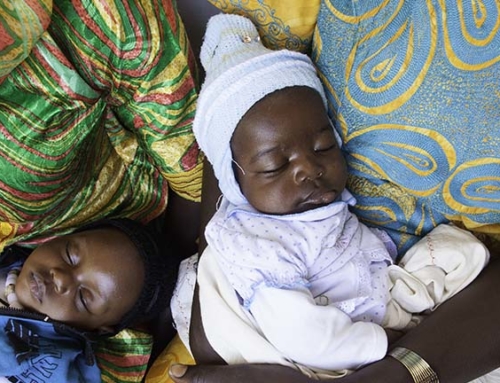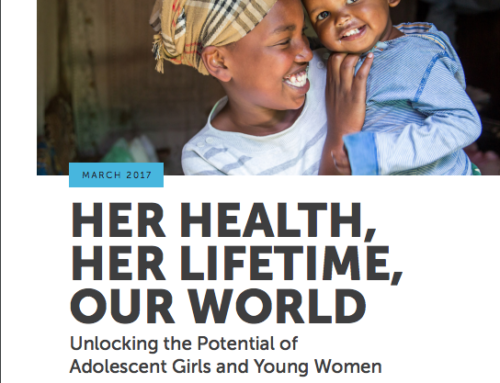In April, I was privileged to travel to Zambia with the CSIS Task Force on Women’s and Family Health. The trip’s focus was the role, benefits, and challenges of public-private partnerships (PPPs), specifically Saving Mothers, Giving Life (SMGL), Pink Ribbon Red Ribbon, and DREAMS. Each of the three tackles a critical health problem in Zambia – respectively, reducing maternal/newborn mortality, preventing and treating cervical cancer, and preventing HIV among adolescent girls and young women. While we saw many promising approaches, I was struck by the extent of the missed opportunities to tackle malnutrition in these health programs.
I have come to know Zambia through my work on maternal and child nutrition and particularly through the Scaling Up Nutrition (SUN) Movement. Zambia is one of 36 countries with a high burden of malnutrition. Forty percent of children younger than 5 are stunted, an indication of chronic malnutrition in early childhood. Most obviously, stunted children are far too short for their age. In some parts of the country, stunting rates are as high as 50 percent, while the rate is at least 36 percent even in better-off regions. National stunting rates are declining – from 53 percent in 2001, to 45 percent in 2007, to 40 percent in 2013-14 – but remain far too high. Stunting causes significant problems that are largely irreversible – poorer health, developmental delays, more trouble learning in school, and even lower lifetime earnings.
According to the SPRING Project, the most recent data — now more than a decade old — suggest that maternal iron deficiency anemia in Zambia is at crisis levels at 47 percent. Anemia causes an increased risk of premature birth, maternal mortality, and child mortality; damages children’s cognitive and physical development; and reduces the physical stamina and productivity of people of all ages. Zambia joined the SUN Movement because leaders recognize the damage that stunting and other forms of malnutrition do to the development of both individuals and the country.
When I was with my Task Force colleagues in Livingstone, the rural Kalomo and Zimba districts of the Southern Province, and in the capital Lusaka, I couldn’t help but think about these nutrition problems in relation to the PPPs focused on women’s health. Stunting can happen very early in pregnancy. High levels of maternal anemia are a significant cause of maternal mortality in Zambia. Were any of the projects addressing these issues? If not, why not? We met young women, often teenagers, who were themselves stunted and getting ready to give birth. They did not look like their pregnancies had reached full term, yet there they were in the delivery ward.
One component of SMGL is known as the Safe Motherhood Action Groups (SMAGs). These are groups of community volunteers who work to educate pregnant women and their families about the importance of giving birth in facilities with skilled birth attendants. We met women who had walked many miles, often with their young children, to spend the last few weeks of their pregnancy in “waiting shelters” close to the district’s only clinic. They had to bring food supplies and cooking utensils because the shelters were not equipped with them. Once a woman gives birth, she and her newborn baby are usually released from the clinic within hours. In Maramba Clinic in Livingstone, for example, we were told that there are not enough beds, so women who give birth without complications are allowed six hours to rest and are then discharged.
Hearing the stories of these women and talking with the nurses and the few doctors at the facilities we visited, I wondered whether pregnant women were being monitored for undernutrition. Were they told what they needed to eat for a healthy pregnancy and baby? Did they have access to these nutritious foods? Did someone explain how to spot early signs of infant malnutrition once they had brought their newborns home to their village?
The three PPPs we looked at were designed to solve specific problems, and their results are promising. For example, maternal mortality rates in districts with SMGL programs have been significantly reduced. But as I asked provincial and district government officials, implementing partners, and the U.S. government’s health team in Zambia about the underlying nutrition issues that affect maternal and newborn health outcomes, it became clear that addressing undernutrition was beyond the scope of SMGL and the other PPPs. The primary focus of SMGL is the 48 hours around labor and delivery, which is too late to help a pregnant woman become better nourished. The district and provincial medical officers acknowledged that nutrition is a neglected issue, but they do not have the resources or the expertise needed to respond effectively. We learned that there may be some additional support from the Swedish aid agency (SIDA) that will enable them to tackle some of the problems in the future.
For me, this experience in Zambia raised many questions:
-
How can we look at women’s and family health more holistically?
-
How can we better help countries deliver services that meet multiple needs and focus on preventing future health problems?
-
How can we increase the impact of existing health service delivery platforms by integrating nutrition interventions?
-
Can we work more effectively across sectors to address nutrition?
-
In rural areas, many of the women and their families are smallholder farmers—how can agriculture and health programs work together?
These are critical questions that must be addressed to improve the impact of U.S. investments in women’s and family health, and most importantly, for the women and children these programs are designed to assist.






